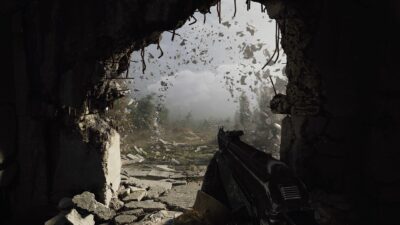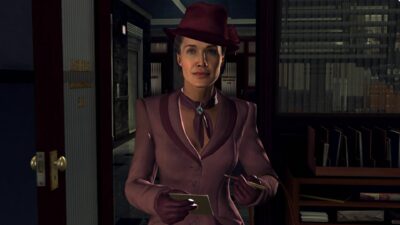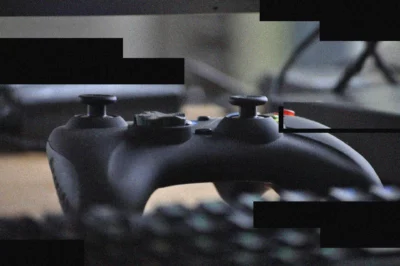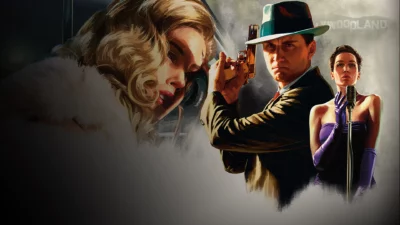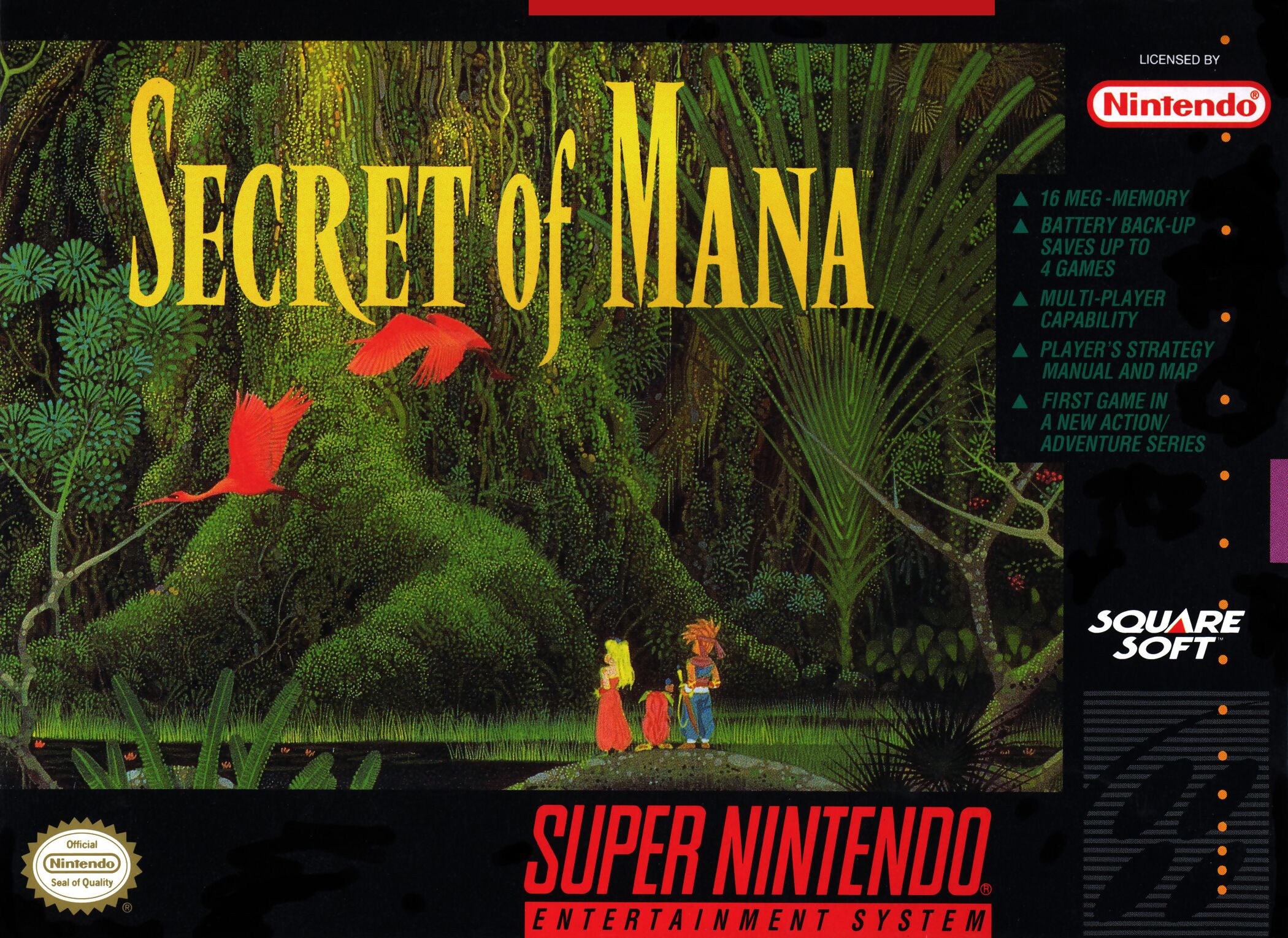
Thirty years on from its release, the real story of classic SNES RPG Secret of Mana isn’t swords and sorcery, but corporate intrigue and business paths not taken.
One of the best reasons to own a SNES back in 1993 was the format-exclusive Secret of Mana – originally released thirty years ago this week on the 6 August.
One of the finest RPGs of all time, Secret of Mana – or Seiken Densetsu 2, as it’s called in Japan – felt like the epitome of the sort of game you just couldn’t buy on rival consoles from the likes of Sega or NEC/Hudson Soft. How ironic, then, that the game’s existence was to prove pivotal in the near-future decline of Nintendo as the dominant player in the home console market, both at home and abroad.
Secret of Mana was the work of SquareSoft (now Square Enix), the most revered 1990s studio making Japan’s favourite and best-selling genre of RPGs – and Square back in 1993 didn’t publish games for anyone but Nintendo. The exhausting experience of making Secret of Mana was about to change all this forever.
A Mana in the works
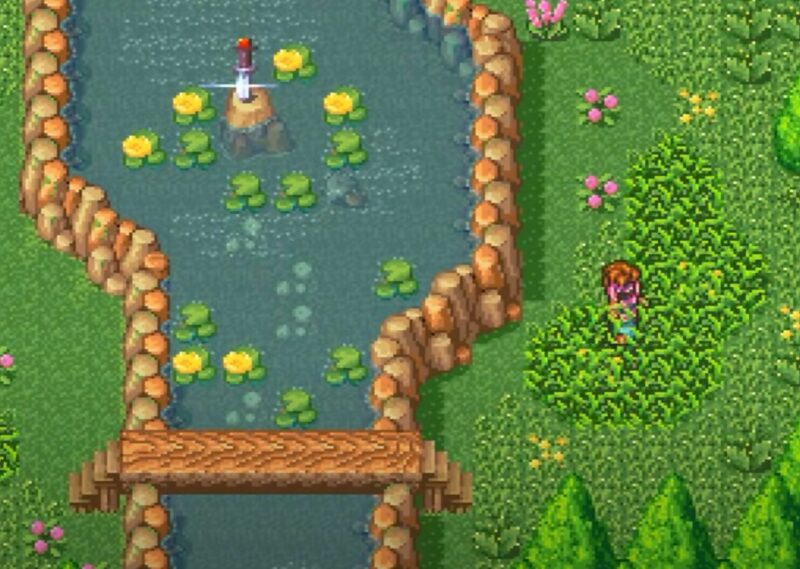
Credit: Square Enix.
The game is a fine example of an action RPG, where the player directly controls characters in bouts of button-bashing real-time combat rather than via fiddly turn-based battle menus, as seen in most other RPGs. Secret of Mana tells the story of three heroes – an unnamed (in the US and European versions) trio of boy, girl and magical water-sprite – and their quest to prevent an evil empire from using the sacred power of the mystical Mana Tree to conquer the world with the aid of a steampunk-style flying fortress.
The graphics are immensely pleasing to this day, with great transparency effects, an immaculately chosen pastel colour-palette, and charming sprite-work. The armour-clad Kid Goblins, who snooze bubbles adorably before being awoken by your approach, and the Mushboom (living mushroom-people with love-hearts on their fungal caps) are so cute that stabbing them in exchange for experience-points feels almost unbearable – but it’s how RPGs work, so you have to.
The use of Mode-7 when flying around the Pilotwings-style map on your big furry white dragon, Flammie (akin to the beast from The Never-Ending Story), was also technically impressive. Even the menu-system, designed around a since-imitated ‘ring command’ mechanic, was a work of design-genius, while the opportunity for three players to take separate control of your trio of warriors via a Super Multitap seemed radical for the day. Plus, not every game has Father Christmas in it, or a title-screen with sampled whale-song calls. (On the subject of sound, Hiroki Kikuta’s evocative score is up there with Super Castlevania IV and Actraiser as one of the finest on the SNES.)
Secret of Mana is an extremely long game, too, providing lots of great replay value. Equally as long, is the story of the game’s troubled gestation.
Mana from Heaven, development Hell
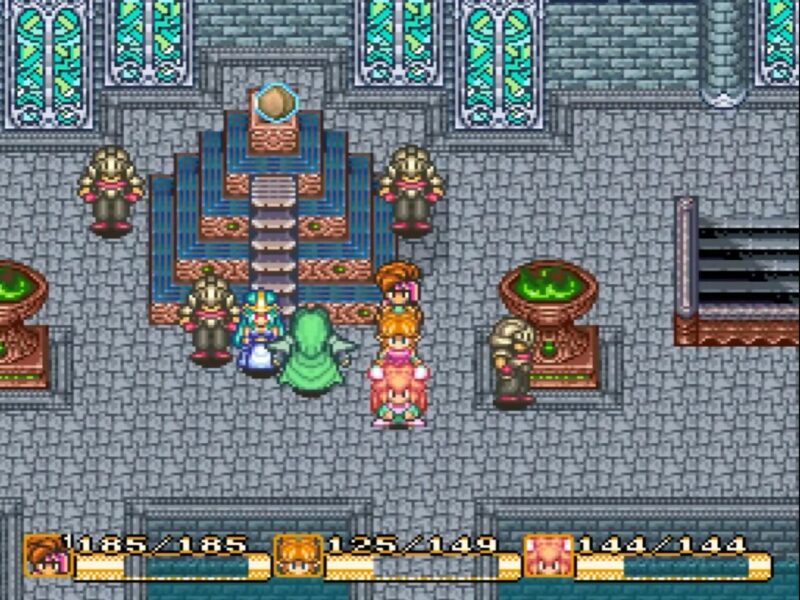
Credit: Square Enix.
From the outside, all looked well. Secret of Mana was Japan’s second best-selling game of 1993, shifting over a million copies, and staying in the USA’s SNES top ten charts through 1993 and into the following year. In Europe, where Square had little meaningful presence, the game was published directly by Nintendo themselves, giving most 16-bit gamers both their first taste of RPG gaming, and of Square’s output itself, thus tightening the bond between Square and Nintendo all the firmer. All of this just shows how appearances can often be deceptive.
Secret of Mana’s development history is exceedingly convoluted. Part of a series known as Seiken Densetsu (or ‘Legend of the Sacred Sword’) in Japan, the first title in the franchise was never actually released at all. Seiken Densetsu: The Emergence of Excalibur, was planned to be an RPG of unprecedented size and scope to be released for the Famicom Disk System (FDS), a Japan-only disk-based medium for the NES. The big concept here the game’s size. It would fill an incredible five disks, and tell a story spanning several generations – presumably one on each disk.
Due for release in April 1987, the game kept getting delayed, and appears to have been pure vapourware. A few screenshots do exist, but seem to have been mock-ups created for adverts which Square foolishly mailed out to potential purchasers.
The Emergence of Excalibur probably existed nowhere beyond paper planning-sheets, an overly-ambitious project which executives happily cancelled in light of both Square’s looming potential bankruptcy at the time, and the declining sales of the FDS itself. In October 1987, Square mailed out refund letters, politely suggesting disappointed pre-purchasers use their returned cash to buy their upcoming genuine piece of software instead – Final Fantasy for the NES, the smash-hit which transformed the fortunes of the entire company.
In 1991, an excellent little ARPG with brilliantly bleepy music called Seiken Densetsu then appeared on Nintendo’s Game Boy handheld, marking the true beginning of the Mana series – which, confusingly, was retitled Final Fantasy Adventure in the US, and Mystic Quest in Europe.
Sharing members of the same original development teams, a few characters from the Final Fantasy games do appear in Seiken Densetsu titles, notably Chocobos and Moogles. Seiken Densetsu II – that is, Secret of Mana – itself started off as Final Fantasy IV, but wound up becoming something else instead, initially being code-named Chrono Trigger during development… but not the RPG later actually released as Chrono Trigger by Square on the SNES in 1995, which was a wholly different game entirely. Or was it?
Now you CD it, now you don’t
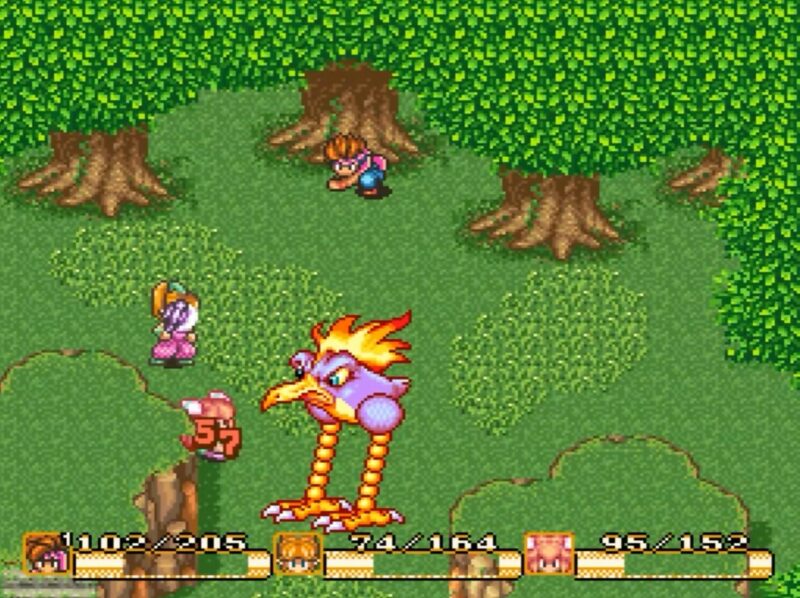
Credit: Square Enix.
The doomed development history of the first Emergence of Excalibur title for FDS was eerily paralleled by that of Seiken Densetsu II, which was originally planned as the flagship launch-title for Nintendo’s upcoming SNES-CD device, supposedly due for release in 1993 or 94.
Cartridge space had become a long-running bone of contention between Square and Nintendo during the 16-bit era, with Nintendo charging such excessive amounts for extra megabytes of memory on their carts that several of Square’s long, story-intensive RPGs ended up costing the equivalent of over $100 in Japan, and hence never leaving home shores. This was a fate which also later befell Seiken Densetsu III, which only saw light of day in the West as part of the Collection of Mana port for the Switch in 2019, now translated as Trials of Mana. Its reams of English-language text apparently wouldn’t fit on the original cart – Japanese being more linguistically compact.
So stretched were Square’s SNES-era memory-resources they actually called the hero in Chrono Trigger ‘Crono’ rather than ‘Chrono’, as the constant omission of the extra ‘h’ actually made a difference in terms of whether or not the 32MB cartridge (extremely large, for the day) could fit all the game’s text in. With the new-fangled 1990s CD-ROM format being able to hold around 650MB on each disc at no extra cost, however, storage of the letter ‘h’ would no longer be an issue.
Therefore, Secret of Mana was originally intended as a massive title which sounded rather reminiscent of the never-made Emergence of Excalibur, which would have involved time-travel and explored the fate of the Mana Kingdom over several generations. Players were initially intended to be confronted with a series of in-game choices leading to several different future paths, making multiple playthroughs necessary to see all the game’s endings.
The SNES-CD was eventually cancelled by Nintendo, though, leading the despairing development team at Square to seek to scrap the project entirely. Square executives refused, forcing them to re-edit the game into a more compact form and release it anyway, to avoid wasting resources. As a result, almost half of the content was cut out and Secret of Mana is estimated to be only 60 percent as long as it was supposed to be.
As for the other missing 40 percent? Well, some of that was re-edited and transformed into the actual game we now know as Chrono Trigger, a time-travel RPG which actually does feature branching paths according to which in-game choices the player makes. The main heroes of both RPGs are a pair of spiky-haired fellows who, to look at, could almost have been twin brothers, separated at birth – which, in a sense, they actually were.
The secrets of Secret
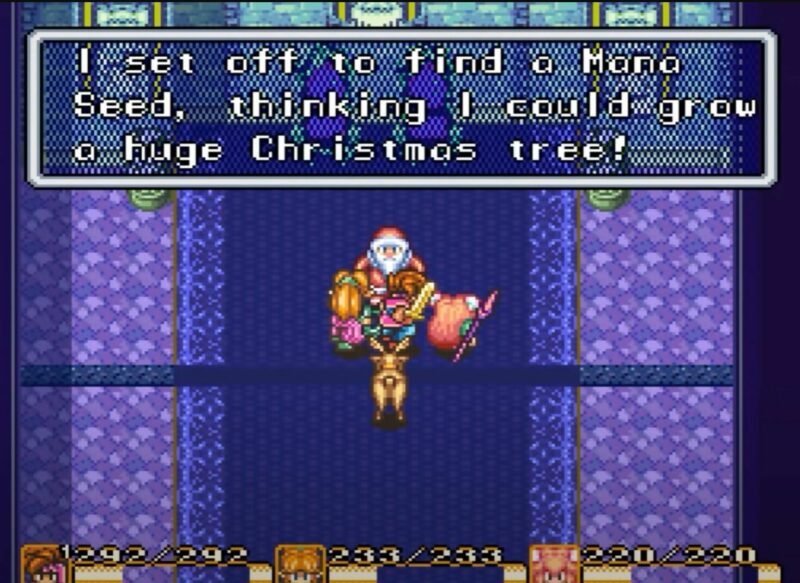
Credit: Square Enix.
From a SNES owner’s point of view, this was perhaps the optimal outcome: Nintendo fans got two great distinct games instead of just one potentially bloated one. The intended full-length Chrono Trigger-style Secret of Mana just wouldn’t have been Secret of Mana as we know it, and wouldn’t necessarily have been as good.
That said, there were negative consequences to the game’s enforced cutting down to size: there are severe graphical glitches during some overcrowded on-screen segments and boss-fights, and the AI of the two computer-controlled heroes when playing alone is frequently confused, getting them stuck in the scenery and sometimes necessitating a reset. Traces of the intended multiple-choice paths remain stuck in the code too, with it being possible to crash the game on occasion as a result of talking to NPCs in the wrong order.
As such, fans have combed through Secret of Mana looking for hidden remnants of uncut content: were passages which go nowhere once intended to lead to whole new realms, or are they deliberate dead-ends meant to confuse the player, as in many a standard RPG maze? Most curious is a large spinning circular thing known as ‘The Carousel’, visible on the Mode-7 map from Flammie’s back, near Empire Northtown. Whatever this is, when you land, it’s nowhere to be seen. What is it? Nobody knows, but a cut item, left on the map by mistake, is the best guess.
Or perhaps it’s a developer in-joke. The Square of the 90s enjoyed confusing players by including bizarre little Easter Eggs. Notoriously, they inserted hidden background faces in several titles, leading some to theorise the company was including secret Satanic messages to corrupt innocent children’s minds. In Secret of Mana, the famous ‘Face On Mars’ optical illusion, from old NASA photos, can also be found on the map screen. Maybe ‘The Carousel’ is actually the Martians’ circular flying saucer?
Elsewhere, another Easter Egg which somehow slipped past Nintendo’s strict 1990s censors was an animation affecting the Mystic Book enemies: haunted flying grimoires which would flick through their pages, casting a spell appropriate to the page they landed on. Very rarely, they would land on a pornographic centre-fold image of a naked blonde woman.
A very CD business
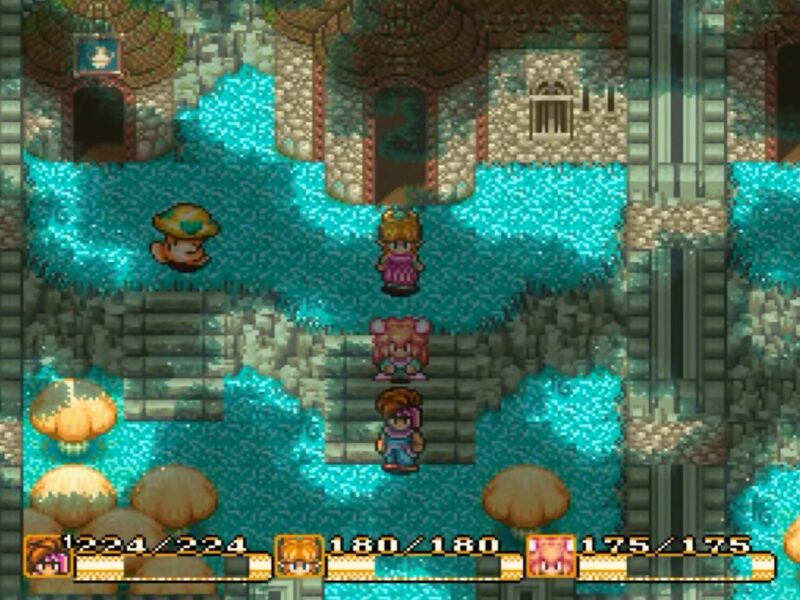
Credit: Square Enix.
What worked out well for the player did not work out well for the developers, however, with their frustrating experiences on Secret of Mana playing a key role in making Square determined to release their next-generation games on a platform which used CDs as a format – something which would mean an inevitable (and bitter) parting of the ways between them and Nintendo.
Nintendo’s President of the day, Hiroshi Yamauchi, hated CDs as being excessively open to piracy, and it was further felt they took too long to load compared to cartridges – points which did have merit. Therefore, when the N64 finally launched in 1996, it was alone among next-generation machines in still using the old physical storage format.
This decision had lasting consequences for Nintendo’s future. Sony had been the original co-developers of the original SNES-CD, using the add-on’s cancellation as a spur to create their own CD-based console, the PlayStation (their original intended name for the SNES-CD itself, as the logo on the sole remaining prototype, which sold for $360,000 in 2020, proved).
CDs provided several invaluable business advantages to third-party publishers over carts besides their greater storage capacity. They were cheaper to manufacture and quicker to print, meaning publishers had less chance of overstocking warehouses with unsold copies in case of an expensive flop, or being unable to get stock out to shops quickly in case of an unexpected hit.
Sony offered publishers far more favourable licensing terms than Nintendo did, too, all of which combined in 1996 to cause Square to finally announce they were shifting development over to Sony wholesale, leading to a bitter total fall-out between the two former allies. Square titles remained entirely absent from Nintendo consoles until partway through the following GameCube generation.
Reputedly, the Final Fantasy games were so popular in Japan that Sony offered Square even better financial terms than usual, clinching the deal. When Enix followed suit soon after, taking the equally popular Dragon Quest series to PlayStation over N64, Sony had the domestic Japanese market all sewn up. As Japan was indisputably the centre of the gaming world in the mid-1990s, this meant inevitable global domination for Sony’s machine over Nintendo’s as well.
Nintendo could have avoided all of this. If only the console giant had listened to Square’s problems when creating Secret of Mana and Chrono Trigger with more sympathetic ears, they would have avoided making the error of eschewing CDs in favour of cartridges. Given that Nintendo’s 64-bit machine was far more powerful than Sony’s 32-bit rival in almost every other respect, you have to imagine Square and Enix would have stuck with them rather than slinking over to Sony, giving Nintendo a third straight generational win in the console wars, following the NES and SNES.
Hence, the biggest Chrono Trigger-style alternative ending hidden away in Secret of Mana’s scrappily edited code is actually one in which Nintendo and Sony’s 32- and 64-bit futures swapped around entirely. Secret of Mana is really Sliding Doors: The Video Game.


